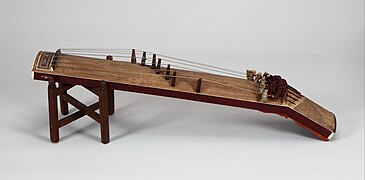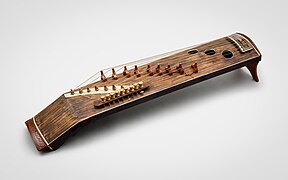Ajaeng
 | |
| Classification | |
|---|---|
| Related instruments | |
| |
| Ajaeng | |
| Hangul | 아쟁 |
|---|---|
| Hanja | |
| Revised Romanization | ajaeng |
| McCune–Reischauer | ajaeng |
The ajaeng (Korean: 아쟁; Hanja:
The ajaeng is generally played while seated on the floor. It has a tone similar to that of a cello, but raspier. Some contemporary players prefer to use an actual horsehair bow rather than a stick, believing the sound to be smoother. The instrument is used in court, aristocratic, and folk music, as well as in contemporary classical music and film scores.
The traditional ajaeng is divided into a daeajaeng (Korean: 대아쟁; Hanja:
Description
[edit]Ajaeng is divided into two types. The ajaeng used in court music is called jeongak ajaeng, and the ajaeng used in folk music is called sanjo ajaeng.[2] The original version of the instrument, and that used in court music (called the jeongak ajaeng), has seven strings; while the ajaeng used for sanjo and sinawi (called the sanjo ajaeng) has eight.
- Types of ajaeng
-
Jeongak ajaeng
-
Sanjo ajaeng
-
Improved ajaeng

The instrument is put on a pedestal called a chosang (초상;
The ajaeng, having its origins in Tang dynasty China,[4][5] was derived from the Chinese yazheng, which was introduced to Korea during the Goryeo dynasty.[6][7]
In 1430, Uiryesangjeongso, the organization for the arrangement of court music and ceremonies arranged the institution of the Goryeo dynasty and included the ajaeng as one of the instruments used to perform Dangak. On the 'Five manners' in the annals of King Sejong, it describes the appearance of the ajaeng. The line was seven, and the left was broken, with catters placed on it.[8]
According to Akhak gwebeom, the ajaeng was used only for Dangak before that time, but at the time of King Seongjong, it was also used for Hyangak.[9]
See also
[edit]References
[edit]- ^ "아쟁". 악기백과 (in Korean). Retrieved 2021-05-21 – via terms.naver.com.
- ^ "아쟁 - 문화콘텐츠닷컴". www.culturecontent.com. Retrieved 2021-06-02.
- ^ 강, 영애. "국악사전". gugak.go.kr (in Korean). Retrieved 2024-07-02.
- ^ Howard, Keith (2020-01-24). Songs for "Great Leaders": Ideology and Creativity in North Korean Music and Dance. Oxford University Press. p. 70. ISBN 978-0-19-007752-5.
- ^ "Ajaeng (아쟁)". KBS World. 2011-05-25. Archived from the original on 2022-10-03.
- ^ "ajaeng | musical instrument". Encyclopædia Britannica. Archived from the original on July 11, 2022.
- ^ Ralls-MacLeod, Karen; Harvey, Graham (2017-09-08). Indigenous Religious Musics. London: Routledge. p. 79. ISBN 978-1-351-56289-8.
- ^ "아쟁(Ajaeng)" (in Korean). Retrieved 2018-04-12.[dead link]
- ^ 장, 사훈. "아쟁(
牙 箏 )". Encyclopedia of Korean Culture. Academy of Korean Studies. Retrieved 2021-05-26.



